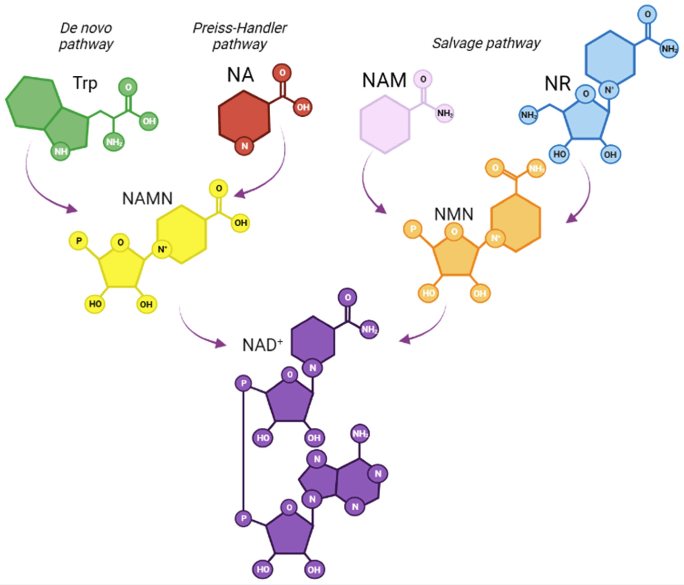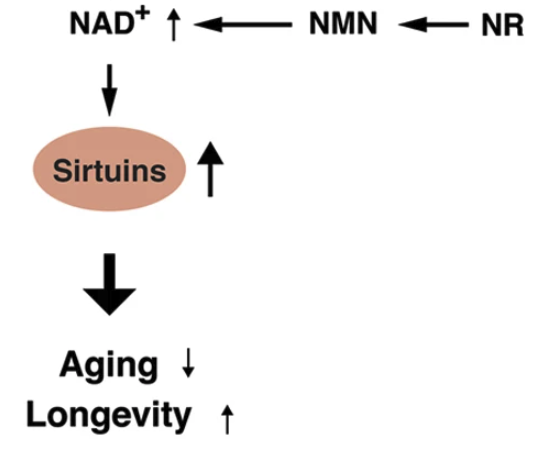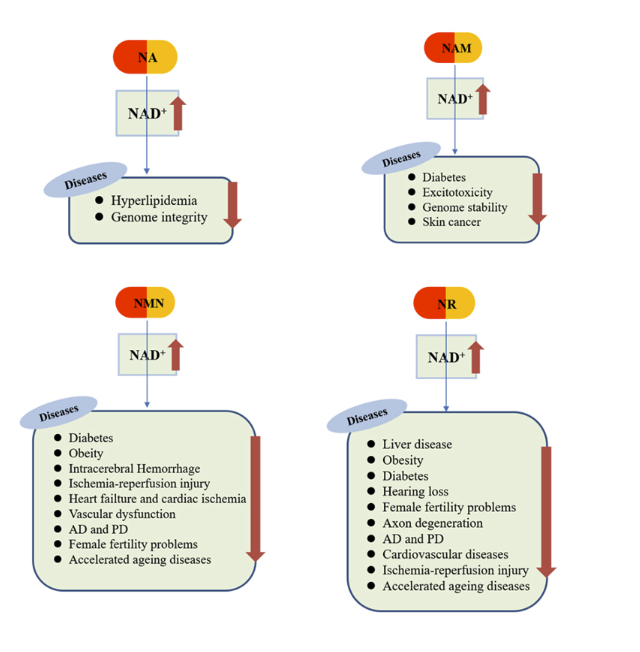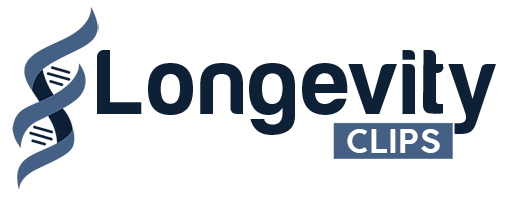Common precursors like Niacin, Nicotinamide Riboside (NR), and Nicotinamide Mononucleotide (NMN) all elevate NAD+, but they do so in surprisingly different ways.
Research suggests that the unique journeys taken by precursors within the body may be just as important as the final NAD+ level they achieve.

Figure: NAD+ biosynthesis in mammals. Structures of NAD+ and NAD+ precursors, Tryptophan (Trp), Nicotinic Acid (NA or Niacin), Nicotinamide (NAM), Nicotinamide Riboside (NR), Nicotinamide Mononucleotide (NMN), Nicotinic Acid Mononucleotide (NAMN).
Niacin Has Unique Cellular Targets
Niacin is known for being a building block for NAD+ and for its ability to lower cholesterol.
Interestingly, its cholesterol-lowering effects seem to primarily operate separately from its role in boosting NAD+ levels.
Niacin interacts with cell receptors (GPCRs), leading to positive changes in blood fat levels. However, this interaction also causes flushing (1).
“While NA (Niacin) has been used in the clinic for many years, there are some adverse effects, such as unpleasant skin flushing, mostly due to activation of the GPR109A receptor by NA (Niacin).” (2)
Emerging research suggests that Niacin’s cholesterol-lowering effect might be more complex and involve additional pathways related to NAD+ or fat processing enzymes (3).
“The mechanism of lipid lowering remains somewhat controversial but may involve inhibition of the diacylglycerol synthesis enzyme DGAT2.” (4)
Animal studies also show Niacin has the potential to prevent or reverse fat buildup and inflammation in the liver through various mechanisms (5).
“Niacin inhibits and reverses hepatic steatosis, inflammation, and prevents fibrosis by reduction of oxidative stress, and inhibition of DGAT2 and other possible mechanisms.” (6)
NMN and NR Target NAD+ Processes
In contrast, NMN and NR appear to take a more targeted approach to cellular health, influencing key processes like DNA repair, mitochondrial function, and overall cell health through enzymes that rely on NAD+ as a fuel source.
These enzymes, called sirtuins, play a crucial role in regulating various cellular functions, and NMN and NR support their activity by ensuring sufficient NAD+ levels (6, 7, 8, 9).
“NMN and NR may be favourable precursors for increasing the level of NAD+ and activating the activity of the NAD+-dependent enzyme, sirtuins.” (10)

Figure adapted from: It takes two to tango: NAD+ and sirtuins in aging/longevity control
NMN and NR Boost NAD+ Without Side Effects
Surprisingly, there are very few studies directly comparing NAD+ precursors in humans.
However, a comparative study in mice revealed key differences in their effects:
- Niacin acted quickly, but resulted in a smaller and shorter-lasting increase in NAD+.
- NR led to a higher and more sustained increase in NAD+.
Recent human trials with NMN and NR have yielded encouraging results.
These trials have shown that NMN and NR can increase blood NAD+ levels by 1.5 to 2.5 times (11, 12, 13, 14). Notably, they avoid the flushing side effect associated with Niacin (15, 16).
“Researchers have paid considerable attention to the precursors NMN and NR in recent years because these are highly efficient in increasing NAD+ levels.” (17)
Functional Diversity in Different Conditions
Different NAD+ precursors may play more significant roles under certain conditions.
- NMN Transporter During Aging: In response to age-related NAD+-decline, the intestine increases the levels of the NMN transporter, which helps NMN enter cells more efficiently to restore NAD+ levels (18).
- NRK2 Enzyme During Stress: In certain stress conditions, the body increases the enzyme NRK2, which recycles NMN and NR. Supplementing NR or NMN can reduce the severity of these conditions (19, 20).
- Condition-Specific Benefits: NMN and NR have been shown to promote the production of blood cells (hematopoiesis), a benefit not observed with Niacin or Nicotinamide (NAM) (21, 22).
- Blood Fat Levels: Among NAD+ precursors, Niacin shows the strongest impact on blood fat levels (23).
Unanswered Questions Hint at Unique Functions
The majority of orally administered NR and NMN is converted into Niacin in the gut, yet they do not induce flushing like pure Niacin and exert unique effects (24). This suggests two possibilities:
- The conversion of NR/NAM to Niacin might be slower or incomplete in the body
- NR and NMN might have additional ways to influence NAD+ levels beyond just converting to Niacin
“Despite being largely converted to NAM or NA, enough NR can reach tissues to promote biological effects.” (25)
Additionally, the full picture of how NMN is utilized in the body remains unclear.
When taken orally, NMN increases various NAD+-related molecules, possibly sourced from the body’s existing stores, rather than being built entirely from the supplement (26).
Pathway to NAD+ Impacts Precursor Effects
While all three precursors – Niacin, NR, and NMN – elevate NAD+ levels, their routes of action within the body are distinct.
Understanding these individual pathways is crucial, as they may have significant effects on outcomes beyond just the NAD+ level itself.
Niacin primarily targets lipid metabolism, influencing cholesterol levels through multiple mechanisms. Interestingly, research also suggests that Niacin influences DNA integrity.
“Increased NA levels have been shown to improve the genome integrity, and NA deficiency has been shown to cause chromosomal instability.” (27)
NMN and NR impact various aspects of aging and metabolic health. Like Niacin, NMN and NR promote cardiovascular health, but through different mechanisms.
“The effects that are observed after the administration of precursors may not necessarily be produced by NAD+, and different functions of the precursor itself or its transformation into other coenzymes may also play a role.” (28)
The figure below summarizes the distinct effects of Niacin, NMN, NR, and another precursor, Nicotinamide (NAM).

Conclusion
Niacin, NR, and NMN all raise NAD+ levels in the body, but they take different routes and may have different effects.
Niacin, the most widely recognized form of vitamin B3, provides various heart health effects in ways beyond raising NAD+ levels. However, it can cause flushing as a side effect.
NR and NMN, on the other hand, appear to be better tolerated and offer a broad range of health benefits associated with NAD+ elevation.
The optimal strategy for NAD+ precursor supplementation likely depends on individual needs and health status.
